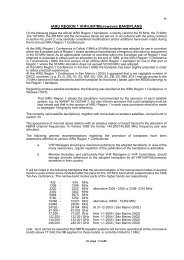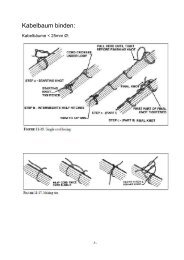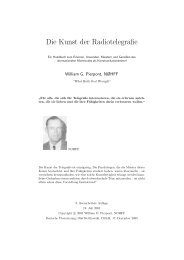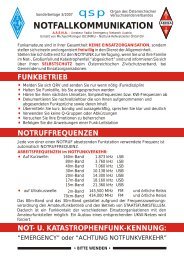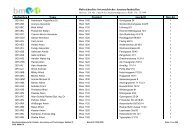SOTA General Rules.pdf
SOTA General Rules.pdf
SOTA General Rules.pdf
- No tags were found...
Create successful ePaper yourself
Turn your PDF publications into a flip-book with our unique Google optimized e-Paper software.
Summits on the Air<strong>General</strong> <strong>Rules</strong>Document reference S0.1Issue number 1.11Date of issue11-Feb-2007Programme start date 02-Mar-2002Authorised John Linford, G3WGV Date 11-Feb-2007Management TeamG0HJQ, G3CWI, G3WGV, GM4ZFZ, M1EYP, MW0IDXNotice“Summits on the Air”, <strong>SOTA</strong> and the <strong>SOTA</strong> logo are trademarks of the Programme. Thisdocument is copyright of the Programme. All other trademarks and copyrights referencedherein are acknowledged.
Summits on the Air – <strong>General</strong> <strong>Rules</strong>Table of contents1 CHANGE CONTROL.................................................................................................................................32 DEFINITIONS.............................................................................................................................................53 PROGRAMME RULES..............................................................................................................................73.1 PURPOSE ...................................................................................................................................................73.2 PROGRAMME STRUCTURE .........................................................................................................................73.2.1 Scope...............................................................................................................................................73.2.2 Programme Management Team......................................................................................................73.2.3 Associations ....................................................................................................................................73.2.4 Regions ...........................................................................................................................................73.2.5 Participants.....................................................................................................................................83.2.6 Programme operation.....................................................................................................................83.3 PROGRAMME START DATE.........................................................................................................................83.4 THE REFERENCE SYSTEM...........................................................................................................................83.5 GUIDELINES FOR THE DEFINITION OF A SUMMIT........................................................................................83.6 ADDING AND DELETING SUMMITS .............................................................................................................93.6.1 Activation of potential summits.......................................................................................................93.6.2 Deletion of Summits........................................................................................................................93.7 RULES FOR ACTIVATORS...........................................................................................................................93.7.1 Criteria for a valid Expedition........................................................................................................93.7.2 Scoring..........................................................................................................................................103.7.3 Care for the environment..............................................................................................................103.7.4 Competence to undertake expedition ............................................................................................103.8 RULES FOR CHASERS ..............................................................................................................................113.8.1 Scoring..........................................................................................................................................113.9 RULES FOR SHORT WAVE LISTENERS (SWL)..........................................................................................113.9.1 Scoring..........................................................................................................................................113.10 MODES AND BANDS............................................................................................................................113.11 SCORING SYSTEM ...............................................................................................................................113.11.1 Alternative scoring strategy option...............................................................................................123.11.2 Seasonal bonus option ..................................................................................................................123.11.3 Activator scoring precedence .......................................................................................................123.12 DOCUMENTATION ..............................................................................................................................123.12.1 <strong>General</strong> <strong>Rules</strong> ...............................................................................................................................133.12.2 Association Reference Manual .....................................................................................................133.12.3 Other documents...........................................................................................................................133.12.4 Precedence....................................................................................................................................133.13 AWARDS.............................................................................................................................................143.13.1 Programme-wide awards..............................................................................................................143.13.2 Association sponsored awards......................................................................................................143.14 ADMINISTRATION...............................................................................................................................143.15 INFORMATION DISSEMINATION...........................................................................................................143.16 <strong>SOTA</strong> FREQUENCIES ..........................................................................................................................153.17 TRADEMARKS AND COPYRIGHT .........................................................................................................153.17.1 Use of the <strong>SOTA</strong> name and Logo..................................................................................................15Page 2 of 15 Document S0.1
Summits on the Air – <strong>General</strong> <strong>Rules</strong>1 Change controlDate Version Details02-Mar-02 1.0 First formal issue of this document06-Mar-02 1.1 Addition of clause in rule 3.4 excluding the use of IOTA continentabbreviations as <strong>SOTA</strong> region descriptions01-Apr-02 1.2 <strong>SOTA</strong> rules separated from the Association Reference Manualsand renamed “<strong>General</strong> <strong>Rules</strong>”.Clarification of wording related to minimum number of qualifyingQSO counts per Expedition.Clarification of bands permitted on expeditions.Correction of minor grammatical errors.23-Apr-02 1.3 Clarification on scoring principles for Activators, Chasers andSWLs added.04-Feb-03 1.4 Clarification of certificate issue policy in Rule 3.13. Inclusion of anSWL certificate.01-Mar-03 1.5 Rule 3.7.1 changed to permit use of other callsigns by Activator.New clause 6 to Rule 3.8 explicitly permits Summit to SummitQSOs to be counted towards Activator’s Chaser score.Rule 3.13.1: Clarification on certificate issuing policy.24-Jun-03 1.6 Rule 3.17 added – trademarks and copyright.19-Aug-03 1.7 Clarification of licensing requirements for Activators, Chasers andSWLs.01-Jan-04 1.8 Rule 3.7.1 clarifies location requirements for the Activator’soperation position.Rule 3.7.4 contains additional safety information.Rule 3.8 implements one claim in 24 hours revision.Rule 3.11.2 updated to include more information on rationale.02-Apr-05 1.9 Rule 3.12 substantially rewritten to bring the documentationrequirements into line with established practice and to clarify thedocumentation obligations of the Association.Clarification of Vertical Separation rule.19-Oct-05 1.10 New clause 12 added to Rule 3.7.1 to clarify activation rules fromSummits that are on the borders of two or more Associations.Rule 3.13.1 substantially rewritten to include the Unique Summitsaward and to clarify certificate issue beyond 1000 points.Page 3 of 15 Document S0.1
Summits on the Air – <strong>General</strong> <strong>Rules</strong>Date Version Details11-Feb-07 1.11 <strong>Rules</strong> 3.2.6 and 3.15 updated to reflect implementation of the<strong>SOTA</strong>Watch system.Rule 3.2.3 amended to avoid conflict with clause 3.14 regardingresponsibility for the appointment of Association Managers.Rule 3.7.1, clause 8 amended to clarify the number of QSOsrequired for a valid activation and to claim points.Rule 3.12.4 updated to clarify precedence in the case oftranslations of the <strong>General</strong> <strong>Rules</strong> into other languagesRule 3.14 amended to normally require that the AssociationManager is a resident national of the Association.Rule 3.17.1 updated to specify web site linking rules for the <strong>SOTA</strong>logo.Page 4 of 15 Document S0.1
Summits on the Air – <strong>General</strong> <strong>Rules</strong>2 DefinitionsThe following terms are defined and have the meanings shown below. Defined terms arecapitalised, e.g. “Activator”. Terms that are themselves used within the following definitionsare shown herein in Italics.TermActivatorASLAssociationAssociation ReferenceManualChaserClassColEntityExpedition<strong>General</strong> <strong>Rules</strong>IncorporatedInternational ReferenceNumberIOTAOperating PositionParticipantDefinitionAn individual or group of individuals that activates a Summit forthe purposes of <strong>SOTA</strong>Above (mean) Sea Level, referring to the height of a SummitAn Entity, Subdivision of an Entity or group of Entities. TheAssociation has an agreed set of parameters and Summits,which complies with the <strong>General</strong> <strong>Rules</strong> and which has beenregistered with and agreed by the Programme ManagementTeam (The Association is said to be Incorporated)The document produced by each Association, containing theAssociation parameters and a listing of all qualifying Summitsand other such information as may be considered useful to thelocal running of the Programme.An individual who participates in <strong>SOTA</strong> by working Activatorsand submitting claimsThe forms that participation in the Programme may take. TheClasses are Activator and ChaserThe lowest point along a ridge between two Summits (alsoknown as a “saddle”)A listing on the DXCC List; a counter for DXCC awards.Previously denoted a DXCC "Country". Seehttp://www.remote.arrl.org/awards/dxcc/rules.html for moreinformationA single visit by an Activator or team of Activators to a Summit inwhich at least the minimum number of QSOs specified in theProgramme are madeThe rules of the Summits on the Air programme, with which allAssociations and Participants must comply.An Association is said to be incorporated when its AssociationReference Manual has been accepted by the ProgrammeManagement TeamA reference in the form G/LD-003 or W-VA/BR-001 whichuniquely identifies a Summit throughout the ProgrammeIslands on the Air. A programme administered by the RadioSociety of Great Britain in which contacts with islands or islandgroups throughout the world can be claimed for awardsThe precise location of the transmitter that is being used by anActivator for the purposes of activating a SummitAny individual who is active within the Programme, includingActivators, Chasers and Short Wave ListenersPage 5 of 15 Document S0.1
Summits on the Air – <strong>General</strong> <strong>Rules</strong>TermProgramme (The)ProgrammeManagement TeamReference NumberRegionRelative HeightSet of <strong>Rules</strong>Short Wave Listener<strong>SOTA</strong>SubdivisionSummitVertical DistanceDefinitionSummits on the Air (abbreviated to <strong>SOTA</strong>)The team charged with overall, worldwide administration of theProgrammeA reference in the form LD-003 which uniquely identifies aSummit within an AssociationA convenient geographical subdivision of the Association intosmaller areas of land for administrative purposes.The height of a Summit, relative to the surrounding countryside.This is not related to height ASL, except where the surroundingcountryside includes coastal areasThe complete rules of the Programme for an Association,comprising the <strong>General</strong> <strong>Rules</strong> and the Association ReferenceManualAn individual who participates in <strong>SOTA</strong> by listening to andlogging the activities of Activators and submitting claimsSummits on the Air (the Programme)The process by which a large DXCC Entity is subdivided intoseveral smaller areas, each of which have the same status as aDXCC EntityA mountain peak that meets the Association’s qualificationcriteria and has been issued a Reference NumberThe maximum permitted drop in height at any point along thestraight line between the Summit and the Operating Position.Page 6 of 15 Document S0.1
Summits on the Air – <strong>General</strong> <strong>Rules</strong>3 Programme <strong>Rules</strong>3.1 PurposeThe purpose of <strong>SOTA</strong> (the Programme) is to encourage Amateur Radio based activity fromthe summits of hills and mountains in countries around the world and to provide an awardsystem for Radio Amateurs in all DXCC Entities.The Programme is intended encourage activity from clearly defined peaks, including majormountains. To enable participation in the Programme to be as wide ranging as possible,lesser peaks can also be included. An incremental scoring system recognises the higherpeaks accordingly. The Programme does not accept operation from or in the immediatevicinity of motor vehicles.The programme provides for participation by Activators who make QSOs from the Summits,Chasers who make contact with the Activators and Short Wave Listeners.3.2 Programme structure3.2.1 ScopeThe Programme is open to all radio amateurs, worldwide. There are no restrictions on whomay activate Summits although it is probable that most activators will live in the generalarea. Chasers and Short Wave Listeners may be in any country, even if there is noAssociation covering their area.3.2.2 Programme Management TeamA small Programme Management Team is responsible for the overall management of the<strong>SOTA</strong> Programme. Specifically, it is responsible for creating and maintaining the <strong>General</strong><strong>Rules</strong> and for determining the suitability proposals made by Associations (see below).3.2.3 AssociationsLogically distinct geographical areas form organisational components of the <strong>SOTA</strong>Programme, known as Associations, by adopting the <strong>General</strong> <strong>Rules</strong>. There are threepossible variants of Association:1. Each DXCC Entity in the world may separately participate in <strong>SOTA</strong>. The Entity forms anAssociation.2. In the case of large DXCC entities, such as the USA, Subdivision, e.g. into states orprovinces, may occur. The area created by Subdivision forms an Association.3. In the case of relatively small DXCC Entities, or groups of Entities that naturally grouptogether, several Entities may form a single AssociationEach Association must have an Association Manager. The Association Manager determinesparameters that are appropriate to local needs. He then creates the Association ReferenceManual and submits it as a proposal for participation to the Programme Management Team.When the Association Reference Manual has been accepted by the ProgrammeManagement Team, the Association is said to be Incorporated.3.2.4 RegionsWithin an Association’s area there may be one or more mountain Regions. These should bedistinct geographically or geologically. From a practical perspective, the number of Regionsshould be limited to a maximum of twelve.Page 7 of 15 Document S0.1
Summits on the Air – <strong>General</strong> <strong>Rules</strong>3.2.5 ParticipantsThere are three Classes of participant: Activators, Chasers and SWLs. Teams may beformed to participate in the Activator Class. Points are awarded in each Class and awardsare available recognising specified levels of achievement.3.2.6 Programme operationThe Programme is managed via the Internet, using web sites, reflectors and e-mail to keepcosts to an absolute minimum. The Programme is self-funding through charges forcertificates, etc. The worldwide <strong>SOTA</strong> web site is at http://www.sota.org.uk. A discussiongroup is available for Expeditions reports and other topics directly related to the Programme,at http://groups.yahoo.com/groups/summits.3.3 Programme start dateThe Programme commences on 2 March 2002. Each Association has its own start datebeing the date that it became Incorporated. Summits can be claimed at any time after thestart date for the responsible Association.3.4 The reference systemEach mountain Region in the Association is assigned a unique two-character identifier.Individual Summits within the Region are assigned a number in the range 001 to 999 (it isnot anticipated that any region will exceed a few hundred Summits; if necessary, subdivisionwill occur).Within an Association, this creates a unique Reference Number in the form, e.g. LD-003.Leading zeros are applied as shown where the number is less than 100. The ReferenceNumber is used throughout the programme to identify the Summit.For the sole purpose of unique identification worldwide, an International <strong>SOTA</strong> ReferenceNumber is created by prefixing the Reference number with the Association description. Thisis either• The ITU allocated prefix, in the event that Subdivision has not occurred, e.g. G/LD-003• The ITU allocated prefix plus the subdivision identifier, where Subdivision has occurred,e.g. W-VA/BR-001To avoid confusion with the Islands on the Air (IOTA) programme, the Summit identifierletters must not be one of the continent abbreviations, namely AF, AN, AS, EU, NA, OC orSA.3.5 Guidelines for the definition of a SummitEach Association is required to determine a strategy for defining a list of Summits that isconsistent with the nature of the general terrain in that Association. The definition must takeaccount of the following guiding principles1. The Association must have sufficient topology to enable meaningful Summits to bedefined. The minimum height for a Summit is 150m above its surroundings. In the eventthat this guideline cannot be met, the Entity or Subdivision will unfortunately, be unableto participate in <strong>SOTA</strong>.2. Summits should be distinct peaks. In general, this means that there should be aminimum vertical separation between Summits and their associated cols (also known assaddles). Peaks separated by a shallow col should be considered as a single Summit.This principle ensures that there is a distinct climb associated with every Summit. AsAssociations will have widely differing mountain characteristics, the Programme does notspecify a minimum separation value. This is for the Association Manager to determine.Page 8 of 15 Document S0.1
Summits on the Air – <strong>General</strong> <strong>Rules</strong>3. The Programme is intended to be inclusive in nature and therefore Summits should notbe limited to the highest points in an Association. To encourage participation by asmany people as possible, any summit that meets the requirements of principle (1) aboveshould be eligible for inclusion in the programme. An Association Reference Manual thatdoes not include a suitably wide range of Summits, when such peaks exist within itsboundaries, is liable to be rejected by the Management Team.4. Summits that are accessible by road can still be included in the programme, thoughoperation from vehicles is not permitted.It is recognised that operation from the exact top of the Summit may be difficult or evenimpossible. It is also important that <strong>SOTA</strong> operations do not disturb the enjoyment of themountains by others. Accordingly, each Association shall define the Vertical Distance fromthe precise summit, within which a Summit operation will be considered valid.3.6 Adding and deleting summitsThe list of Summits for an Association is not necessarily exhaustive. It is acceptable that thelist will evolve over time, as the Programme develops within the Association.Summits can be added to the Programme provided they meet the definition agreed for theAssociation. A Summit that is added in this way will be valid for general activation from thedate that the Reference Number is issued.3.6.1 Activation of potential summitsActivators of potential new summits should provide materials to the appropriate RegionManager and Association Manager, prior to the Expedition, which demonstrate that thecriteria are met. A reference number will then be issued by the Association Manager. If thesummit is activated before a reference number has been issued then points may, at theAssociation Manager’s discretion, be retrospectively claimed for the expedition, but only if areference number for the summit is subsequently issued.3.6.2 Deletion of SummitsA Summit will be deleted if it fails to meet the criteria (e.g. due to more accurate mapping).Existing credits for the summit, for activation prior to its deletion, will be retained.3.7 <strong>Rules</strong> for ActivatorsAll Expeditions must use legitimate access routes and comply with any local rules regardinguse of the land. In particular, Activators must ensure that they have any necessarypermission to operate from their chosen Summit. Note particularly that it may not beacceptable to camp overnight in any area of mountainous terrain, without permission fromthe landowner.3.7.1 Criteria for a valid ExpeditionFor an Expedition to be considered valid, the following criteria must be met:1. The Activator must hold an appropriate transmitting licence.2. All operation must comply with the amateur radio licensing regulations and must use thepermitted amateur radio bands of the country in which the Association is based.3. The method of final access to the Summit must be “person powered”. Valid methodsinclude hiking, skiing, mountain biking.4. The Operating Position must be within the permitted Vertical Distance of the Summit, asdefined in Rule 3.5. The terrain between the operating position and the actual Summitmust not fall below the permitted Vertical Distance.5. All equipment must be carried to the site by the Activator team.Page 9 of 15 Document S0.1
Summits on the Air – <strong>General</strong> <strong>Rules</strong>6. All equipment must be operated from a portable power source (batteries, solar cells, etc).Operation is expressly forbidden using permanently installed power sources or fossil-fuelgenerators of any kind.7. All operation must comply with any limitations on the use of transmitting equipment thatmay exist for the Summit.8. At least one QSO must be made from the Summit. In order for the activation to qualifyfor the points attributed to that Summit, a minimum of four QSOs must be made, each ofwhich must be with a different station.9. QSOs with others on the same summit do not count towards the QSO total.10. QSOs via terrestrial repeaters do not count towards the QSO total.11. Activator points accrue to the operator regardless of the callsign used. The operatormust be entitled to use the callsign. Multiple operators of the same station may claimactivator points. Each individual operator must make the minimum number of QSOsstated above in order to claim Activator points.12. Activators must submit a log of the Expedition in order to claim points. In the event thata claim is not to be made, Activators are still asked to submit logs so that Chaser claimscan be substantiated. Logs may be submitted by filling in an entry form on the <strong>SOTA</strong>web site or as a log file. Full details are on the <strong>SOTA</strong> web site.13. Where the mountain peak has been issued a reference number in two or moreAssociations, the Activator may only claim points from one Association in any oneascent. The Summit ascent must start from within the owning Association and theOperating Position must also be within the Association. The same peak may beactivated once per year in each Association but each activation must be a separateascent.3.7.2 ScoringThe Activator claims the Summit points on an expedition basis, regardless of the totalnumber of QSOs made above the qualifying minimum. A Summit may be activated as oftenas desired but an individual Activator can only claim points for operation from a particularSummit once in any calendar year.QSL cards are not required.3.7.3 Care for the environmentActivators must not cause any damage to the environment. This includes damage to themountain itself, walls, fences, livestock, buildings, etc. Any Activator who is found to havedeliberately or carelessly caused such damage may be, at the Programme ManagementTeam’s discretion, excluded from the programme.Activators are required to operate in a manner that is in keeping with the spirit of theProgramme.Activators must operate with due consideration for other people on the hills. Excessivenoise, inconsiderate siting of equipment and antennas, etc. is not acceptable and potentiallybrings the Programme into disrepute. Evidence of such behaviour may result, at theProgramme Management Team’s discretion, in exclusion from the programme.3.7.4 Competence to undertake expeditionActivators must be competent to undertake their proposed Expedition and must carrysuitable equipment, taking account of the terrain, weather conditions, etc. Activators takepart in the Programme entirely at their own risk and the Programme in its entirety shallaccept no responsibility for injury, loss of life or any other loss.Page 10 of 15 Document S0.1
Summits on the Air – <strong>General</strong> <strong>Rules</strong>Activators are reminded that hill climbing is an inherently hazardous activity. Accidents canand do happen in the mountains and the risk is neither increased nor mitigated by the <strong>SOTA</strong>programme.3.8 <strong>Rules</strong> for Chasers1. The Chaser must hold an appropriate transmitting licence.2. The Chaser must make a QSO with the Summit Expedition, in which at least callsignsand two-way reports are exchanged. Wherever possible, the <strong>SOTA</strong> Reference Numbershould also be obtained as part of the QSO.3. With effect from 01-Jan-2004, only one QSO with a given Summit in any 24 hour periodcounts for points. The 24 hour period is defined as 00:00 to 23:59 local time at thelocation of the Summit.4. QSOs via terrestrial repeaters do not count for points.5. Chasers who wish to participate in the award scheme must submit a log showing detailsof all QSOs with Expeditions for which they wish to claim points.6. QSL cards are not required.7. An Activator may claim Chaser points for QSOs made with Activators on other Summitsduring his Expedition.3.8.1 ScoringThe Summit score is claimed for a single QSO with the Expedition. Multiple QSOs with thesame Expedition do not attract additional points.3.9 <strong>Rules</strong> for Short Wave Listeners (SWL)1. Anyone can participate in the SWL section, whether they hold an amateur radio licenceor not.2. The SWL must receive a QSO between the Summit Expedition and any other radioamateur, during which at least callsigns and two-way reports are exchanged. Thisinformation must be recorded by the SWL. Where the <strong>SOTA</strong> Reference Number is givenas part of the QSO this must be recorded.3. Only one QSO per Expedition counts for points. When an Expedition comprises severalteam members, only one QSO with the entire Expedition counts for points.4. QSOs via terrestrial repeaters do not count for points.5. SWLs who wish to participate in the award scheme must submit a log showing details ofall QSOs heard with Expeditions for which they wish to claim points.6. QSL cards are not required.3.9.1 ScoringThe Summit score is claimed for hearing a single QSO with the Expedition. Multiple QSOsheard with the same Expedition do not attract additional points.3.10 Modes and bandsAll modes and amateur radio bands are valid for the Programme.3.11 Scoring systemA scoring system relating to the height of the Summit ASL must be implemented unless thisis clearly and demonstrably impractical (see below). Each Summit is worth a certain numberPage 11 of 15 Document S0.1
Summits on the Air – <strong>General</strong> <strong>Rules</strong>of points, dependent upon its height ASL. Six height bands are defined, expressed inmetres ASL and optionally in feet ASL, the values of which are determined on anAssociation basis. Height bands for an Association are determined by the AssociationManager and must be shown in the Association Reference Manual.Points are awarded to both Activators and Chasers as follows:Band 1 1 pointBand 2 2 pointsBand 3 4 pointsBand 4 6 pointsBand 5 8 pointsBand 6 10 pointsThe height banding must be constructed in such a way that it encourages operation from thehighest peaks in the Association. Therefore, Band 6 should only apply to a small proportion,say 10%, of Summits. Conversely, a reasonable number of Summits must fall into Band 1 toencourage lower level participation. Again, as a guideline 10% of Summits is acceptable.3.11.1 Alternative scoring strategy optionWhere it can be shown that a scoring system based on altitude is demonstrably impracticalthen the Association Manager shall propose an alternative scoring system for approval bythe Programme Management Team. Such a system must take into account the full range ofSummits in the Association.It shall be the Association Manager’s responsibility to establish the need for such analternative scoring system and to provide evidence to the satisfaction of the ProgrammeManagement Team.3.11.2 Seasonal bonus optionA seasonal bonus may be made available to all Activators undertaking Expeditions within anAssociation, at the discretion of the Association Manager. The seasonal bonus is intendedto reflect the fact that for safe travel in the hills at during the bonus period, extra safetyequipment is necessary plus the skills to use it. The bonus may, for example, be applied towinter conditions where there is significant seasonal variation in temperatures or to otherparameters, such as monsoon seasons, etc.There shall be only seasonal bonus period in a year, up to a maximum duration of fourmonths. The bonus shall only apply to Expeditions to the higher Summits and shall be, in allcases, three points. The Association Manager shall determine eligibility of his Associationfor the seasonal bonus, bearing in mind local safety considerations. He shall also define theinclusive dates that constitute the bonus period and the minimum height of qualifyingSummits.3.11.3 Activator scoring precedenceIn the event that an Activator activates a Summit more than once during the year, he mayclaim points for any one Expedition. If one expedition was during the period that theseasonal bonus was in operation, then he can claim that expedition together with the higherscore.3.12 DocumentationThe <strong>SOTA</strong> document library is maintained as Microsoft Word documents and is published inAdobe PDF format. All <strong>SOTA</strong> documents must be formatted to accurately conform to the<strong>SOTA</strong> house style. Templates are available on request.Page 12 of 15 Document S0.1
Summits on the Air – <strong>General</strong> <strong>Rules</strong>All documents have a unique document number which is issued by the ProgrammeManagement Team to indicate that the document has been officially released. A register ismaintained listing all officially released documents.3.12.1 <strong>General</strong> <strong>Rules</strong>The <strong>General</strong> <strong>Rules</strong> (this document) provides a framework in which The Programmeoperates. It is maintained by the Programme Management Team.3.12.2 Association Reference ManualEach Association Manager shall create an Association Reference Manual (ARM), whichcomprises Association-specific data that customises The Programme to the needs of theAssociation’s area.ARMs shall be published in English and optionally in any other language that is appropriateto the Association.The ARM shall comprise the following sections:• Chapter 1 – Change control• Chapter 2 – Association Reference Data. At a minimum, this must contain theAssociation parameters but it may also contain general information of use to prospectiveparticipants• Chapter 3 – Summit Reference Data. This chapter contains the eligible summits intabular form. The tables may be split into Regions and may also contain Region specificinformation of use to prospective participants. The minimum information required in thetables is:1. The <strong>SOTA</strong> Reference Number.2. The name of the Summit. Preferably this should be the name shown on local maps.If no such name is shown then a locally used name may be used.3. The location, accurate to no worse than 250 metres, using the generally acceptedreference system of the country in which the Association is based. The Maidenheadlocator system is not considered adequate for this requirement. Nationallyrecognised rectangular reference systems or latitude and longitude are acceptable.4. The height of the Summit in metres ASL.5. The height of the Summit in feet ASL.6. The score associated with the Summit.It is the Association Manager’s responsibility to maintain the ARM as new Summits areadded or other changes become necessary. The Association Manager must send theupdated manual to the Programme Management Team whenever changes are made.The ARM is authorised by the Programme Management Team. An Association onlybecomes operational in The Programme when its ARM has been duly authorised.3.12.3 Other documentsOther documents may be produced by The Programme from time to time.3.12.4 PrecedenceThe <strong>General</strong> <strong>Rules</strong> have precedence over the Association Reference Manual in case of anyconflict. The <strong>General</strong> <strong>Rules</strong> also have precedence over all other programme documentation,official or otherwise; e.g. Activator’s Guidelines, etc. Where the <strong>General</strong> <strong>Rules</strong> have beentranslated into other languages, the English version has precedence over other languageversions in case of any conflict.Page 13 of 15 Document S0.1
Summits on the Air – <strong>General</strong> <strong>Rules</strong>3.13 Awards3.13.1 Programme-wide awardsCertificates and plaques are awarded to recognise achievement in the entire <strong>SOTA</strong>Programme, comprising all Associations.There are two categories of award:• All Summits award. All summits count, subject to the qualification criteria of Rule 3.7,Rule 3.8 or Rule 3.9, as appropriate• Unique Summits award. Each Summit counts only once, regardless of the number ofqualifying activationsCertificates will be awarded for 100, 250, 500, 1000, 2500, 5000 points, and so on insequence, in each award categories. Separate certificates are awarded in the Activators,Chasers and SWL sections.In the All Summits award category, the following trophies will be awarded upon request:• “Mountain Goat” trophy for Activators who attain 1000 points.• “Shack Sloth” trophy for Chasers who attain 1000 points.• “SWL” trophy for Short Wave Listeners who attain 1000 points.All certificates and trophies are issued upon request, by the Programme ManagementTeam’s Awards Administrator, based on logs uploaded to the on-line database. A charge ismade to cover the costs.3.13.2 Association sponsored awardsIn addition to Programme-wide certificates and trophies, Associations may specify their ownaward system, which is administered by the Association Manager. These award systemsmust be defined in the Association Reference Manual.3.14 AdministrationThe Programme Management Team administers the Programme on a volunteer basis. TheProgramme Management Team has overall responsibility for the operation of theProgramme in all Associations and its decisions are final.The Programme Management Team shall appoint an Association Manager for eachAssociation, normally a resident national, who is responsible for advising on theProgramme’s operation in that Association. In particular, the Association Manager createsand maintains the Association Reference Manual for his Association and agrees its contentswith the Programme Management Team.The Association Manager will at his discretion, appoint Region Managers as required in eachmountainous region of an Association, to provide local knowledge for the AssociationManager and the Programme Management Team. The Region Manager can also becontacted to provide advice for would-be Activators planning to visit the area.3.15 Information disseminationSummit Activators are encouraged to publicise their intended Expeditions to maximise theopportunity for Chasers to make contact. Internet facilities have been set up for the purposeto which any interested party may subscribe.Lists of summits that have been allocated numbers will be maintained on the Web. Theprogramme rules for each Association will be published on the web site.Page 14 of 15 Document S0.1
Summits on the Air – <strong>General</strong> <strong>Rules</strong>3.16 <strong>SOTA</strong> frequenciesThere are no specified <strong>SOTA</strong> frequencies but Activators are encouraged to suggestfrequencies on which they will be operational for specific Expeditions. As operations arelikely to be QRP, the use of internationally recognised QRP frequencies should beconsidered.3.17 Trademarks and Copyright“Summits on the Air”, <strong>SOTA</strong> and the <strong>SOTA</strong> logo are trademarks of the Programme. Alldocuments published by The Programme are the copyright of The Programme.3.17.1 Use of the <strong>SOTA</strong> name and LogoThe <strong>SOTA</strong> name and Logo may be freely used for non-commercial purposes that are clearlyrelated to the programme. Examples might be the use of the Logo on a QSL card, or as partof a personal web site.Commercial organisations wishing to make use of the <strong>SOTA</strong> name or Logo must firstdiscuss their plans with, and obtain agreement from the Programme Management Team.In all cases the <strong>SOTA</strong> Logo, as displayed, must be unaltered in any way including content,colour and aspect ratio. Its overall size may be adjusted to fit the layout of the document.Where the <strong>SOTA</strong> logo is used on a web site the logo graphic may optionally include a link tothe official <strong>SOTA</strong> web site, http://sota.org.uk. It is not acceptable to link from the <strong>SOTA</strong> logographic to any other site.Page 15 of 15 Document S0.1




